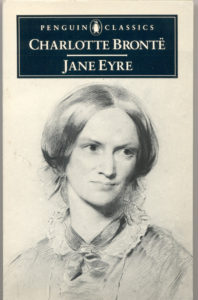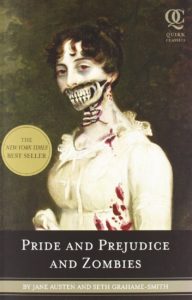By Faith Aeriel
This year sees the publication of Howard Johnson’s Shylock is My Name and the premier of Pride and Prejudice and Zombies. Stories like Homer’s Iliad, Jane Austen’s Pride and Prejudice, Charlotte Bronte’s Jane Eyre, and countless Shakespeare plays refuse to remain confined to their original form: whether it be the lines of a book or those spoken by actors. Some stories enter and exit our lives like characters walking across a stage. They say a few nice words, but they don’t linger long in our minds. Others take up residence in our hearts and are carried with us forever. What sets these stories apart, and why are readers so reluctant to let some stories remain in the past?
“The ancient stories that survived [did so] because they keep speaking to us,” said Madeline Miller, author of The Song of Achilles, which was awarded the 2012 Orange Prize for Fiction. “They held up a psychological mirror, and I think we just keep seeing ourselves in it.”
It is widely agreed that these stories are retold because of some inherent truth within them that applies to readers’ lives, regardless of the passage of time, but narrowing down just what that truth is can present more of a problem. According to Beau North, author the 2015 retelling of Pride and Prejudice titled Longbourn’s Songbird, much of this can be found in the complexity of the original work and the vastness of the characters and setting. This complexity inevitably leaves certain aspects of the story undiscovered, allowing another writer the opportunity to explore it further. Austen’s works are a prime target for retellings when considering the huge network of character motivations that are largely driven by social expectations of the time. Meanwhile, stories like Homer’s Iliad and Virgil’s Aeneid particularly inspire retellings, Miller pointed out, as they originated as an oral tradition that were passed from generation to generation and were given new life through each retelling. Another motivation for writers is the desire to share their passion for the subject with others: both Miller and North hope that their interpretations will make the stories more accessible to modern readers and spark new interest in the original works.
The challenge for the writer is how to present a well-known story with originality, while still staying true to the initial version.
“For me it always felt like a dance,” said Miller. “I was stepping toward the myths and then I was stepping away. When I would get stuck, it was either because I was too close to Homer or I was too far from Homer.”
Oftentimes the writer will choose to tell the story from another character’s perspective, to allow for a new interpretation of the same events. Miller and North both use this tactic in one way or another: Miller retells the events leading up to, and during, Homer’s Iliad from Patroclus’ perspective, while North utilizes a variety of character perspectives to investigate motivations that were only alluded to in Pride and Prejudice.
“I’d always planned for Longbourn’s Songbird to be Pride and Prejudice told from Colonel Fitzwilliam’s point of view, but that quickly got away from me,” said North. “The more detailed I got in backstory, the more I wanted to broaden that scope to include the other characters.”
Inevitably, characters will differ from the versions found in the original texts as the writer brings their own ideas of them to light. For example, in Miller’s version of events, Achilles is portrayed much more sympathetically than Homer’s Achilles, while Agamemnon is shown in a more critical light. These character traits were the result of Miller’s interpretations of the characters beyond what was explicitly written in the Iliad. She saw many of Achilles’ flaws as having originated from his trusting nature and his youthful inexperience. On the other hand she felt that “Agamemnon got off lightly in the myths,” and people tend to be more willing to accept his poor leadership and egotism solely because he is the head of the army that is eventually victorious.
North also navigated her character through a tight channel somewhere between Austen’s and her own interpretations. While many of the characters largely retain their original qualities, she explores their motivations in more depth, such as with Elizabeth and Georgiana Darcy. However, with other characters, it proved necessary to deviate further from the original to tie together plot points and modernize certain elements of the story, which is set in the post WWII American South.
“The biggest departure from canon in my story is Charlotte Lucas’ character,” said North of Elizabeth’s prudent friend who North portrayed as a lesbian. “When you remove the necessity of an advantageous marriage from the equation, how does [Charlotte] show us that folly of ruthless practicality? How does she come to settle for Mr. Collins?”
Similarly, plot points may deviate in delivery, but, ideally, will still closely reflect the original. For Miller, the key was changing not only the perspective from which the story was told, but also shifting the form from an epic—which focuses on the heroics, death, war, and fate in Achilles’ story—to a lyric mode—which instead focuses on friendship, daily life, and love.
Both Miller and North encourage readers to return to the original texts if they enjoyed the reimagined versions, so they can also experience the characters and stories that were so vibrant they demanded to be told again. Miller even suggests listening to Homer or Virgil, rather than reading them, so as to experience the stories as the ancients would have.
“These ancient poems were meant to be shared with everyone,” said Miller. “They were stories that were retold and retold. They were meant for everyone and I wanted to honor that in the way I wrote the book so that it could be for both audiences: audiences who knew the myths and audiences who were new to the myths.”
 Faith Aeriel is a freelance writer and journalist. She has formerly worked as Associate Editor for Manhattan Book Review, San Francisco Book Review, and Kids’ BookBuzz, during which time she was responsible for writing articles, blog posts, and interviewing authors, as well as editing and managing incoming content for the websites. Faith loves books, cinnamon rolls, and cats.
Faith Aeriel is a freelance writer and journalist. She has formerly worked as Associate Editor for Manhattan Book Review, San Francisco Book Review, and Kids’ BookBuzz, during which time she was responsible for writing articles, blog posts, and interviewing authors, as well as editing and managing incoming content for the websites. Faith loves books, cinnamon rolls, and cats.
You can learn more about Faith on her booklover’s blog.







Recent Comments